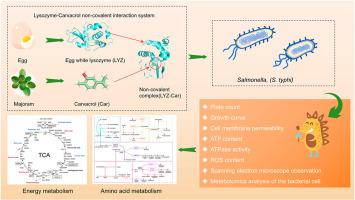溶菌酶和香芹酚作为食品安全抗菌剂通过破坏TCA循环和氨基酸利用协同根除沙门氏菌
IF 6.6
1区 农林科学
Q1 FOOD SCIENCE & TECHNOLOGY
引用次数: 0
摘要
在单纯溶菌酶(LYZ)对沙门氏菌杀灭作用有限的基础上,本研究通过添加香芹酚(Car)显著增强LYZ对沙门氏菌的杀灭活性。平板计数、生长曲线分析、扫描电镜证实,LYZ-Car组合明显抑制细菌生长,造成严重的形态损伤。机制研究表明,联合处理使外膜通透性提高了约1.6倍,细胞内活性氧(ROS)水平提高了1.9倍。此外,ATP酶活性和ATP含量明显受到抑制,分别下降1.5倍和1.4倍,表明能量代谢严重中断。代谢组学分析鉴定出129个显著改变的代谢物,并揭示了16个关键代谢途径的严重紊乱,其中氨基酸代谢和TCA循环受到的影响最为严重。这些定量结果证实了LYZ-Car组合有效地抑制和根除沙门氏菌,为提高食品安全提供了一个有希望的策略。本文章由计算机程序翻译,如有差异,请以英文原文为准。

Lysozyme and carvacrol as food-safe antimicrobials synergistically eradicate Salmonella by disrupting TCA cycle and amino acid utilization
Based on the limited bactericidal effect of lysozyme (LYZ) alone against Salmonella, this study significantly enhanced the bactericidal activity of LYZ by adding carvacrol (Car). Plate counting, growth curve analysis, and scanning electron microscopy confirmed that the LYZ-Car combination significantly inhibited bacterial growth and caused severe morphological damage. Mechanistic investigations revealed that the combined treatment increased outer membrane permeability by approximately 1.6-fold and elevated intracellular reactive oxygen species (ROS) levels by 1.9-fold. Furthermore, ATPase activity and ATP content were markedly suppressed, showing reductions of 1.5-fold and 1.4-fold, respectively, indicating severe disruption of energy metabolism. Metabolomics analysis identified 129 significantly altered metabolites and revealed profound disturbances in 16 key metabolic pathways, with amino acid metabolism and the TCA cycle being the most severely affected. These quantitative results confirm that the LYZ-Car combination effectively inhibits and eradicates Salmonella, offering a promising strategy for enhancing food safety.
求助全文
通过发布文献求助,成功后即可免费获取论文全文。
去求助
来源期刊

LWT - Food Science and Technology
工程技术-食品科技
CiteScore
11.80
自引率
6.70%
发文量
1724
审稿时长
65 days
期刊介绍:
LWT - Food Science and Technology is an international journal that publishes innovative papers in the fields of food chemistry, biochemistry, microbiology, technology and nutrition. The work described should be innovative either in the approach or in the methods used. The significance of the results either for the science community or for the food industry must also be specified. Contributions written in English are welcomed in the form of review articles, short reviews, research papers, and research notes. Papers featuring animal trials and cell cultures are outside the scope of the journal and will not be considered for publication.
 求助内容:
求助内容: 应助结果提醒方式:
应助结果提醒方式:


